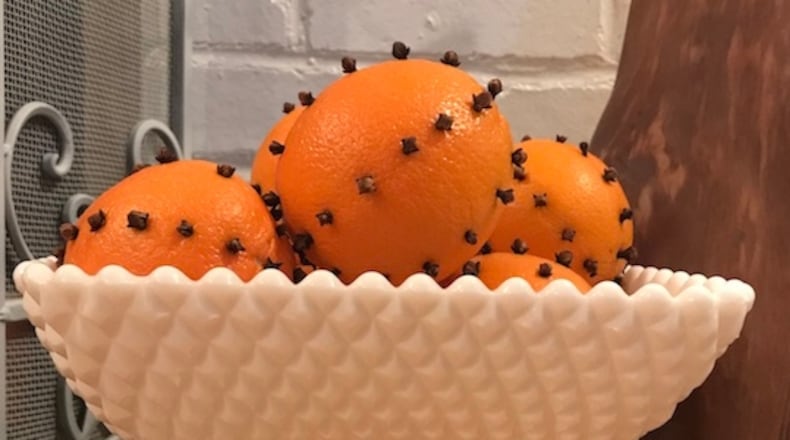As the pandemic continues, many of us are looking for crafts to keep our hands and minds occupied. We’ve made plenty of sourdough, grown gardens, and maybe done some home remodeling projects, too. So, what else is there to do?
Here are a few simple projects you can make with family, or for yourself. Best of all, they’re cheap (or free) and use everyday ingredients you probably have on hand.
Credit: Julia Skinner
Credit: Julia Skinner
Clove ink
As long as humans have been around, we’ve used ingredients from the natural world for inks, dyes and paints. Homemade ink can be made just by raiding your pantry or garden, and it’s fun and simple to explore the different colors you can get. The cloves in this recipe give you a deep, rich brown, while turmeric makes a vibrant yellow ink. Even grass or leaves from your yard can be used for greens, yellows and browns. And, as an added bonus to using fragrant spices, your whole house smells delicious!
- Add 2-4 tablespoons of whole cloves to a nonreactive saucepan. The more cloves you add, the darker the ink (note: making ink will dye your pan, so use a pan you aren’t very attached to).
- Add 2 cups of water, and bring to a simmer.
- Simmer your ink for about an hour, or until the water is reduced by half (if it isn’t dark enough, simmer it a bit longer).
- Allow your ink to cool before using, and store any unused portion in the fridge.
Pinecone bird feeders
This project might give you some nostalgia for your elementary school arts and crafts days. We made these in art class each winter, to welcome migratory birds coming back home in early spring. The process is simple, and the payoff is big: In addition to a fun craft, you get the joy of watching wild birds gather in your yard.
- Lay down newspaper on your table for easier cleanup.
- Gather as many pinecones as you would like. This process works best with large, sturdy pinecones that can withstand handling.
- Using a butter knife or spoon (or your hands) cover your pinecones in creamy peanut butter, getting it as much into each nook and cranny as possible.
- Pour birdseed onto a plate, and roll your pinecones in it, to evenly coat them.
- Tie a piece of ribbon or twine around the pinecone’s stem, or around the pinecone itself, making a knot to hold the string in place, and using the loose ends to secure it to a branch.
Citrus vinegar
This is a fun way to use up those leftover peels and scraps from making juice or cooking with citrus, and it makes for a fragrant, inexpensive household cleaner (just don’t use it on granite). This works well with any kind of citrus, or with a mixture.
- Add citrus peels to a nonreactive container, like a glass jar or plastic tub.
- Add white vinegar to cover, and allow to steep for two to four weeks.
Credit: Julia Skinner
Credit: Julia Skinner
Pomanders
Clove-studded pomanders were popular in Victorian England, but are still loved today. This wintertime craft uses in-season oranges as its base, for an aromatic centerpiece that will leave your home smelling cozy and warm.
- Select several firm, thick-skinned oranges (like navel oranges).
- Take whole cloves and insert them into the oranges by pressing them, tapered end first, in whatever design you desire. Many people make straight lines, but swirls and other designs are fun, too.
Credit: Julia Skinner
Credit: Julia Skinner
Popcorn garlands
Popcorn isn’t just for eating, it’s great to decorate with, too. Another popular Victorian-era craft still around today is the popcorn garland, and these are a fun way to dress up your home or outdoor spaces (outdoor garlands make great food for wildlife, too). For a pop of color, alternate popcorn kernels with cranberries.
- Pop at least 4 cups of plain popcorn.
- Taking a needle and thread, carefully pierce each piece of popcorn through its thickest point, and string them onto the garland, leaving a bit of thread loose at each end.
- Tie the ends into loops, and hang your garland.
Credit: Julia Skinner
Credit: Julia Skinner
Drawer sachets
Drawer sachets are a great way to repurpose old fabric scraps or clothes into something useful. They are wonderful with lavender, but any whole herb or spice works, and the fragrance lasts for months.
- Cut your fabric into 4-by-4-inch squares.
- Place 1-2 tablespoons of whole lavender flowers in the center of each square.
- Pick up the four corners of your square and hold them in the middle, forming a pouch around your lavender.
- Secure with twine.
Julia Skinner is an author and director of Root, an Atlanta-based food history and fermentation company. Find more of her recipes and fun ideas at root-kitchens.com/signup, or by following @rootkitchens.
Read more stories like this by liking Atlanta Restaurant Scene on Facebook, following @ATLDiningNews on Twitter and @ajcdining on Instagram.
About the Author
The Latest
Featured






